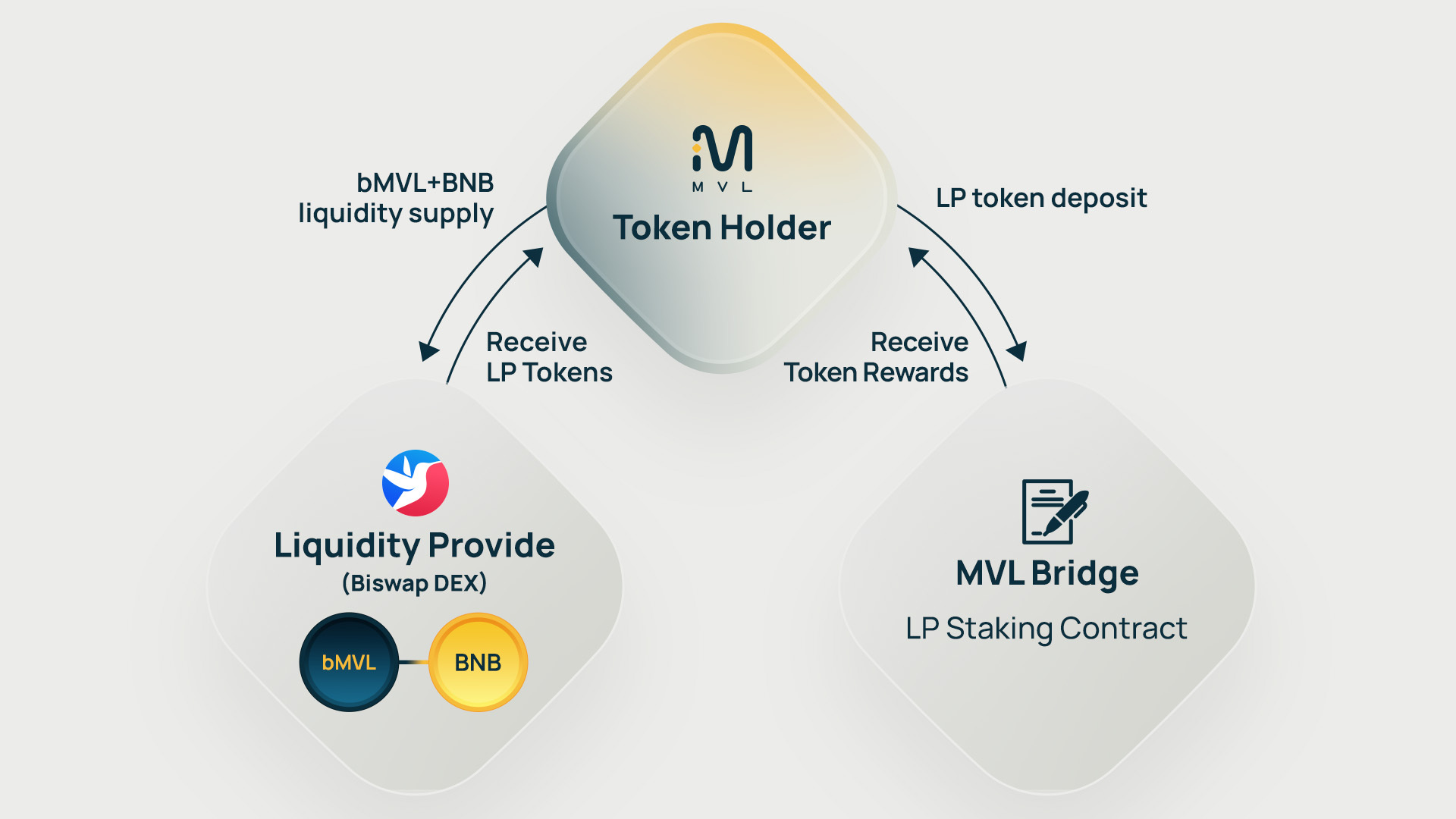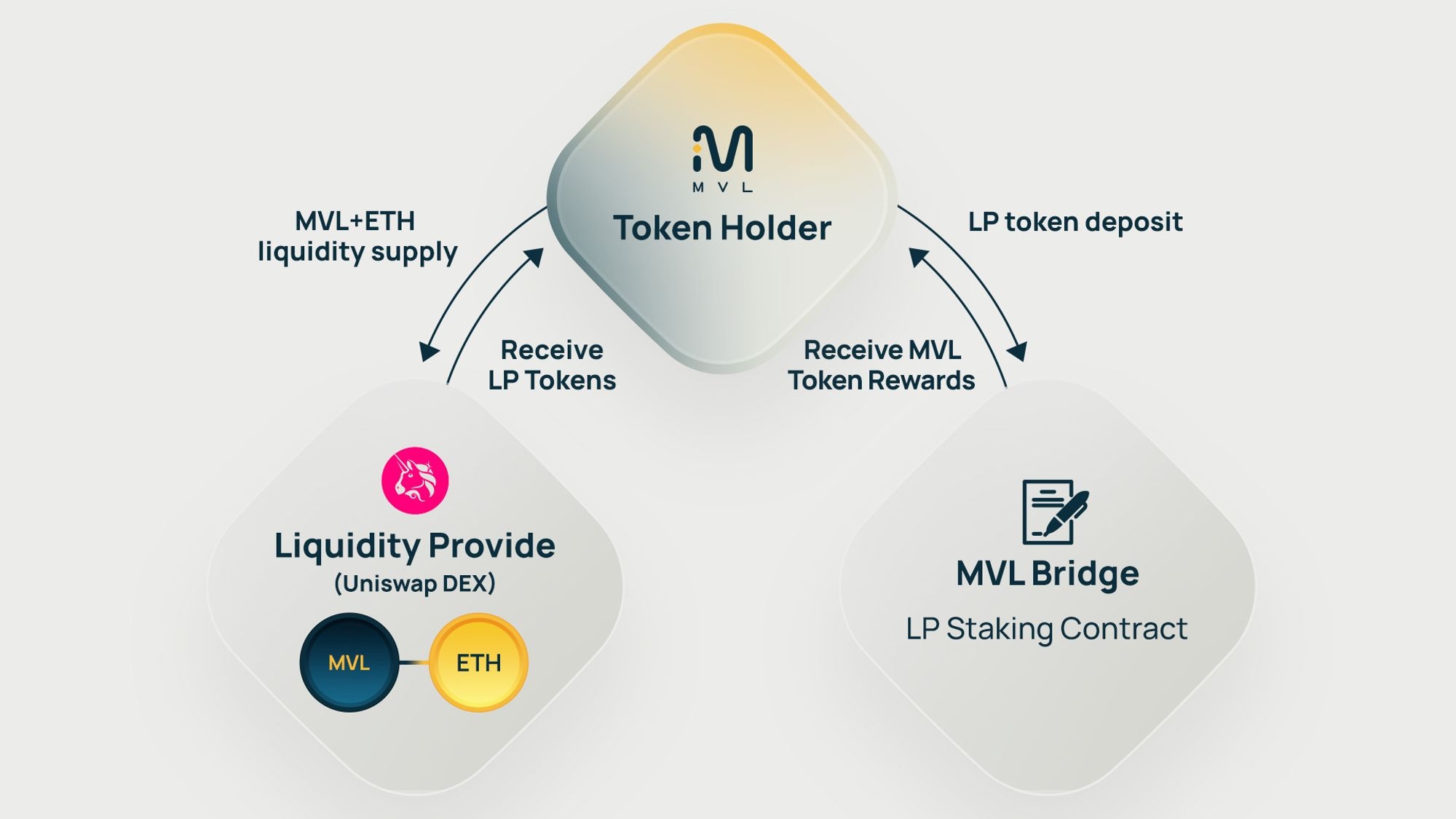Staking Farms
Basic Concept
Depositing two pairs of tokens in the AMM DEX to form a sufficient liquidity pool for token trading is called Liquidity Providing.
DEX provides LP tokens to liquidity providers as proof of deposit.
People who hold LP tokens, that is, liquidity-providing participants, can earn a certain amount of commission when a transaction occurs in the pool, but may incur impermanent losses due to the token price changes.
Sufficient liquidity providing is a very important aspect underlying the MVL Incentive Protocol, where active operation of MVL(ERC20) and bMVL(BEP20) tokens on-chain is important. Therefore, the concept of LP Staking is to provide rewards to those who participate in liquidity providing.
See below for more detailed concepts.
Details
DEX(Decentrallized Exchange) & AMM(Automatic Market Maker)
What is DEX(Decentrallized Exchange)?
It is a decentralized token exchange (DEX) that operates on the blockchain with smart contracts, in contrast to centralized exchanges (CEX) such as Binance and Upbit.
There are two main types of DEX: Order book type DEX and AMM type DEX. Order book DEXs include dYdX, and AMM DEXs include Uniswap, Sushiswap, Pancakeswap, and Biswap.
Among them, the method used for trading in Clutch wallet refers to AMM DEX, and we have signed a partnership with Biswap DEX, which is rapidly growing in BNB Chain, to provide liquidity.
What is AMM(Automatic Market Maker)?
Unlike the order book method in which trades are concluded by buying and selling orders on the order book, it is a method of trading with AMM through a pre-configured liquidity pool.
This is an algorithm that works by depositing two types of token assets in a contract in advance (liquidity providing), and putting one token into the corresponding liquidity pool, and the other token coming out.
In the most basic and popular form of AMM, CPMM (Constant-Product Market Maker) AMM works by making the product of the quantity of two tokens deposited in the contract constant.
As an example of MVL, Biswap DEX currently provides a liquidity pool consisting of a BNB-bMVL token pair, and in Clutch wallet, you can use this pool to onchain trade such as sending BNB Coin and receiving bMVL tokens.
The AMM method has the advantage of always providing liquidity regardless of the token's transaction volume or the size of the liquidity pool, and that transactions can be concluded immediately.
However, it also has the following limitations.
Loss by trade volume (Price Impact)
When the size of the liquidity pool is small, price impact (slippage) occurs during trading. → It can be solved by inducing sufficient liquidity providing to market participants.
Impermanent Loss of Liquidity Providers (Imperment Loss)
If the price of the tokens, which composed the liquidity pool, changes, the amount of tokens may be lost. → It can be solved by providing additional compensation in addition to the fees to liquidity providers.
It is important for MVL holders to participate in liquidity providing for better operation of the Mobility Incentive Protocol that the MVL team is trying to implement. Therefore, MVL plans to provide LP Staking service.
The Importance of Liquidity Providing
What is Price Impact in AMM DEX?
Swapping two tokens on the AMM DEX will result in a price difference from the market price. This is called Price Impact or Slippage.
As mentioned earlier, AMM transactions work in such a way that the product of the two tokens deposited in the contract is always constant.
However, according to this formula, when you trade, a price difference from the market price occurs, resulting in a certain amount of loss.
Let's look at the following example. Assuming the current price of Ethereum is 2,000 USDT,
Current Status
10
20,000
200,000
-
-
Sell 1 ETH
11
18,181.8
200,000
1,818.2 USDT
181.8
Buy 1 ETH
9
22,222.2
200,000
2,222.2 USDT
222.2
In the example above, if you sell 1 ETH, AMM will put 1 ETH into the pool and take out the corresponding USDT, and if you buy 1 ETH, you will put USDT in and take out ETH
At this time, the product of the ETH quantity and the USDT quantity remains constant at 200,000.
However, the actual contract price is different from the Ethereum price of 2,000 USDT. If you sell ETH, you will receive 181.8 USDT less, and if you buy ETH, you will buy with 222.2 USDT more.
As an example, the price impact is the loss incurred by the token trader due to the AMM algorithm.
The Importance of Liquidity Providing
Sufficient liquidity providing is critical to being able to absorb sufficient transaction volume on-chain.
The larger the amount of tokens pre-deposited in the liquidity pool on AMM DEX, the smaller the price impact when trading the same amount of tokens.
This makes it easier to trade tokens and reduces price volatility of tokens even when trading large amounts of tokens at one time.
As a result, many projects provide various incentives for participants to supply more token liquidity. The most representative method is LP Staking.
What is LP Token?
If you add liquidity to the liquidity pool of AMM DEX, you will receive a certain amount of LP tokens.
LP tokens are a proof that you have supplied tokens to a certain liquidity pool.
LP token holders can dismantle them and withdraw the tokens deposited in the liquidity pool at any time. At this time, the fees earned through the liquidity pool can also be recovered together.
Precautions when liquidity providing - Impermanent Loss
What is Impermanent Loss?
Generally when liquidity is supplied to DEXs with LPs, impermanent losses are incurred.
Impermanent loss refers to the difference in asset value when the token price fluctuates as:
when two tokens are bundled in LP
simply kept as a single token
The impermanent loss occurs as the change in relative value between two assets increases.
There is no impermanent loss occurs if the relative value rises and falls at the same rate.
For a detailed explanation of the concept of impermanent loss, please refer to the document below.
Impermanent Loss Calculator
Need to introduce LP Staking
Liquidity providing from multiple participants is essential for MVL's Web3 project operation.
In order to provide incentives beyond impermanent loss to the liquidity providers, MVL team proceeds with LP Staking.
LP Staking is when a liquidity provider deposits LP tokens, which are the tokens for liquidity providing, in the LP Staking contract, the incentive is given in proportion to the deposit amount and deposit period.
LP Staking (BNB-bMVL LP)
Basics
When the MVL Incentive Protocol is officially launched, the users who achieve specific missions in Web2 services such as TADA can receive MVL as a reward. The MVL received at this time can be exchanged for real bMVL tokens at any time in the Clutch wallet. After that, the users can store and use bMVL tokens in the Clutch wallet, and also can trade bMVL tokens if necessary.
Transactions of bMVL tokens in Clutch Wallet hold on the BNB Blockchain Network. At this time, the liquidity providing for the transaction is carried out using Biswap DEX's BNB-bMVL Liquidity Pool.
From now on, providing sufficient liquidity for stable exchange and transactions of bMVL tokens is required. To encourage the participation of many holders, MVL Fi will provide BNB-bMVL LP Staking service.
BNB-bMVL LP Staking Structure
BNB-bMVL LP Staking will follow the below structure.

Liquidity providing stage
Provide liquidity to the BNB-bMVL pair on the Biswap DEX and receive BNB-bMVL LP tokens.
LP Staking stage
Deposit BNB-bMVL LP tokens in MVL Fi Farm and receive bMVL as an incentive according to the amount and period of deposit.
LP Staking (ETH-MVL LP)
Basics
Transactions of MVL tokens in Clutch Wallet hold on the ETH Blockchain Network. At this time, the liquidity providing for the transaction is carried out using Uniswap DEX's ETH-MVL Liquidity Pool.
From now on, providing sufficient liquidity for stable exchange and transactions of MVL tokens is required. To encourage the participation of many holders, MVL Fi will provide ETH-MVL LP Staking service.
ETH-MVL LP Staking Structure
ETH-MVL LP Staking will follow the below structure.

Liquidity providing stage
Provide liquidity to the ETH-MVL pair on the Uniswap DEX and receive ETH-MVL LP tokens.
LP Staking stage
Deposit ETH-MVL LP tokens in MVL Fi Farms and receive MVL as an incentive according to the amount and period of deposit.
LP Staking Spec.
BNB-bMVL LP Token Address
ETH-MVL LP Token Address
BNB-bMVL LP Token (Add Liquidity)
Add Liquidity on MVL Fi
Add Liquidity on Biswap
ETH-MVL LP Token (Add Liquidity)
Add Liquidity on MVL Fi
Add Liquidity on Uniswap
BNB-bMVL Liquidity Pool Monitoring
Dex.guru
ETH-MVL Liquidity Pool Monitoring
Dex.guru
Etherscan
BNB-bMVL LP Staking
LP Staking on MVL Fi
1st LP Staking Contract (22.12.21~23.12.23)
2nd LP Staking Contract (23.12.21~24.12.21)
3rd LP Staking Contract (24.12.23~)
ETH-MVL LP Staking
LP Staking on MVL Fi
1st LP Staking Contract (23.02.22~11.22)
2nd LP Staking Contract (23.11.24~24.11.26)
3rd LP Staking Contract (24.11.28~)
Last updated